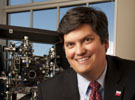Marc Christensen is New Dean of SMU’s
Bobby B. Lyle School of Engineering
Marc Christensen, a nationally recognized expert in light technology, is the new dean of the Lyle School.

DALLAS (SMU) – Marc Christensen, a nationally recognized leader in photonics – the science and technology of light – has been named dean of SMU’s Bobby B. Lyle School of Engineering.
Christensen, 41, has served as interim dean in the Lyle School since July 1, 2012, and assumes the new position immediately.
“Dr. Christensen has been setting a strong example of collaborative leadership, innovative research and commitment to students since he began his career at the Lyle School in 2002,” said SMU President R. Gerald Turner. “That he has become dean in little more than a decade is testament to both his achievements and his high expectations for the Lyle School and for himself. He is well-equipped to lead the Lyle School as it continues its rise to prominence.”
“Marc is highly regarded in the Lyle School, across the campus and in the scientific community,” said SMU Provost Paul Ludden. “He is personally immersed in the innovative education style that is the Lyle School’s signature, and has solidified the Lyle School’s academic offerings and research footprint as interim dean. We congratulate him in his new role.“
Christensen will continue as the engineering school’s Bobby B. Lyle Professor of Engineering Innovation and as a research professor in the Department of Physics in SMU’s Dedman College of Humanities and Sciences.
“I am excited about the opportunity to serve as dean of the Lyle School at this critical juncture,” Christensen said, "and I am proud of the quality of our faculty, the dedication of our staff, and the poise and creativity of our students. SMU-Lyle is making a difference – preparing our students to be innovative leaders, engaging them in our classrooms, our research labs and our community. We will support SMU’s pursuit of excellence in graduate and undergraduate programs while maintaining a strategic focus on the research enterprise, and I look forward to collaborating with the other fine schools across SMU’s campus."
Christensen received his Bachelor’s degree in engineering physics from Cornell University. He received his Master’s degree in electrical engineering and his Ph.D. in electrical computer engineering at George Mason University. He also is a graduate of the Harvard Institutes for Higher Education Management Development Program.
Christensen is a recognized leader in mapping photonic technology onto varied applications. In 2007, the Defense Advanced Research Projects Agency (DARPA) identified him as a “rising star in microsystems research” and selected him to be one of the first DARPA Young Faculty Award recipients.
From 1991-1998, while pursuing undergraduate and graduate degrees, Christensen was a staff member and technical leader in BDM’s Sensors and Photonics group (now part of Northrop Grumman Mission Systems). In 1997, he co-founded Applied Photonics, a free-space optical interconnection module company.
Joining SMU in 2002, Christensen served as chair of the Electrical Engineering Department from 2007 – 2012.
In 2008, Christensen was recognized at SMU for outstanding research with the Gerald J. Ford Research Fellowship, and in 2011 he was recognized for outstanding and innovative teaching as a recipient of the Altshuler Distinguished Teaching Professor Award.
Christensen has co-authored more than 100 journal and conference papers. He has two patents in the field of free space optical interconnections, one patent pending in the field of integrated photonics, and four pending in the field of computational imaging.
###
SMU is a nationally ranked private university in Dallas founded 100 years ago. Today, SMU enrolls nearly 11,000 students who benefit from the academic opportunities and international reach of seven degree-granting schools.
SMU’s Bobby Lyle School of Engineering, founded in 1925, is one of the oldest engineering schools in the Southwest. The school offers eight undergraduate and 29 graduate programs, including masters and doctoral degrees.